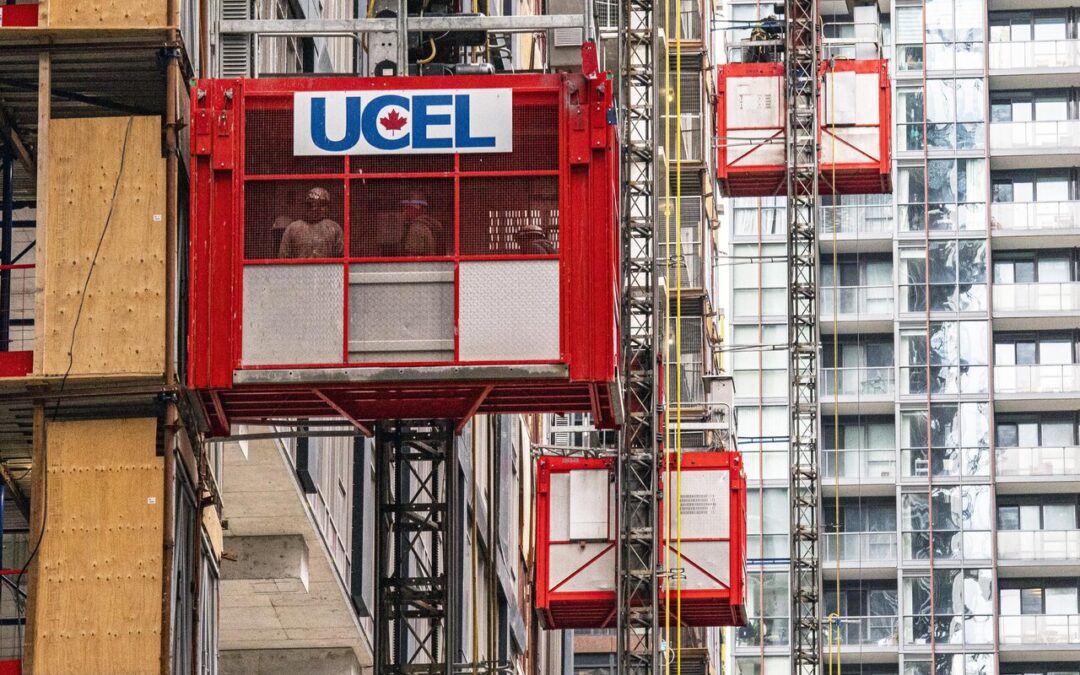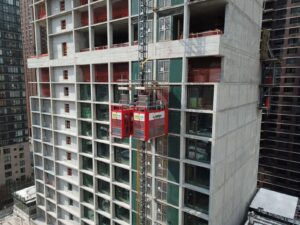Construction lifts are essential equipment in any construction project. In this guide, we will explore different types of construction lifts, what they are typically used for, and when a construction elevator is an ideal choice.
What is a Construction Lift?
Construction lifts are machinery used in construction projects to hoist and transport materials, tools, and personnel to various heights making work easier, faster, and safer. The type of lift you choose will depend on your particular needs and the nature of your project.
Types of Construction Lifts
Scissor Lifts
These versatile lifts offer a safe, efficient way to transport personnel and materials. They are designed to vertically lift and lower people and heavy loads, making them perfect for indoor and outdoor activities. Scissor lifts come in different sizes and heights, fitting the requirements of various construction projects.
Boom Lifts
Used to lift people and materials to elevated heights, boom lifts are ideal for construction projects that require access to hard-to-reach areas. They are designed with a long, extendable arm that can move horizontally and vertically, allowing workers to reach areas that are difficult to access. These lifts are available in different types, including telescopic and articulated boom lifts.
Personnel Lifts
Also known as man lifts, these lifts are designed to lift people. They come in different types, including vertical personnel lifts and inclined personnel lifts. These lifts are great for tasks such as painting, maintenance, and installation of overhead fixtures.
Material Lifts
These lifts are used to move heavy loads vertically and horizontally and are designed to transport materials such as equipment, appliances, and building supplies to different floors. Material lifts are available in different types, including vertical reciprocating conveyors, platform lifts, and pallet lifts.
Cherry Pickers
Also known as aerial work platforms, cherry pickers are used to lift people and materials. They are designed with a hydraulic arm that can extend and retract, allowing workers to reach high areas. Cherry pickers are ideal for tasks such as painting, window cleaning, and construction of high-rise buildings.
How to Choose the Right Construction Lift
Selecting the right construction lift depends on the type of project you plan to use it for and the tasks you need it to perform. First consider factors such as material height and weight, personnel to be lifted, and work area location, and then examine the different types of lifts and their specific capabilities. With these factors in mind, you should have the information necessary to confidently select the right construction lift for your project.
Buying Versus Renting a Construction Lift
Whether to rent or buy a construction lift depends on your requirements and the duration of your project. If you need the lift for a short period, it may be more cost-effective to rent one. Renting also gives you access to the latest equipment without the cost of ownership.
If you need the lift for an extended period, it may make financial sense to buy one. Owning also gives you the flexibility to use the lift whenever you need to without worrying about rental schedules. Ultimately, the decision to rent or buy a construction lift depends on your needs and your project.
What’s the Difference Between a Construction Lift and a Construction Elevator?
Both construction lifts and construction elevators hoist and transport materials, tools, and personnel to different heights at a construction site.
“Construction elevator”, UCEL’s bread and butter, is synonymous with construction lifts and falls under this umbrella term, but typically refers directly to rack-and-pinion man and material lifts meant for heavy-duty low-, medium-, and high-rise projects.
“Construction lift” is a more versatile term and used to describe a wider range of products.
Construction Lift FAQs
Q: What is the weight limit for a construction lift?
A: The construction lift weight limit depends on the lift type and manufacturer’s specifications. You should always check the weight limit of a lift before using it to ensure that it can safely handle the weight of your materials or personnel.
Q: How often should a construction lift be inspected?
A: Construction lifts should be inspected before each use and at regular intervals as directed by the manufacturer and local regulations. Additionally, if a lift has been in storage for an extended period, it should be inspected before use to ensure that it is in good working condition.
Q: Are construction lifts safe to use?
A: Yes, construction lifts are safe to use when used properly and according to the manufacturer’s instructions. However, it is essential to follow all safety guidelines, such as wearing appropriate personal protective equipment (PPE), ensuring that the lift is on stable ground, and using the lift only for its intended purpose.
Q: Do I need special training to use a construction lift?
A: Yes, anyone operating a construction lift must have proper training and certification. The requirements may vary depending on the type of lift and your location, so it is essential to check local regulations and receive proper training before using a lift.
Construction lifts are incredibly useful and important pieces of equipment that power the work at many different kinds of construction sites. Use this guide to help you select the right construction lift for your project. Contact the experts at UCEL if you have any questions about the lift recommended for your specific application.

